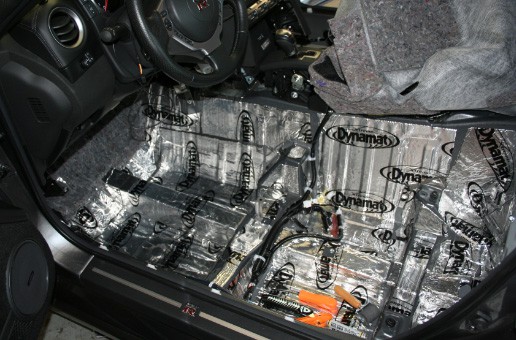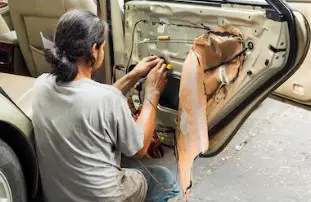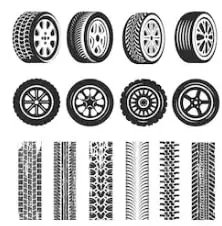Is it almost impossible to try and carry on a normal conversation in your car? Then it’s time to learn how to reduce road noise in a car.
Excessive road noise in a car can be very annoying, especially if you have a fully packed car with friends or family. Not only is it annoying to try and have a conversation, but having a loud car can also make long road trips agonizing.
Can’t you just turn on the music really loud? You sure can, but if you’re like me, sometimes I like to drive without music.
So you won’t be able to rely on this temporary fix 100% of the time. This also doesn’t solve the issue when you have passengers in the car with you.
Not every vehicle on the road will have this problem. Some vehicles are just better at keeping noise at a minimum when driving, while other cars are just horrible.
Electric cars are usually whispered silently; however, jeeps, trucks, and big SUVs are often a lot louder.
Whether you decided to make your car louder yourself or you have a car that is loud in general, there are many ways to help reduce this noise.
I’ve researched the topic of soundproofing a car for several hours and just wanted to share what I have learned with you in this article. Let’s take a look at how to reduce road noise in a car.
The Best Way to Reduce Road Noise in a Car

Dynamat is a soundproof foam that you place underneath the floor mats under the two front seats of your car.
The way these foam works is by soaking up excess sound made by your car’s tires that enter through your cabin.
Dynamat is one of the most well-known soundproof foams on the market.
The main problem with Dynamat is that it is really expensive, but it doesn’t have anything that makes it better than the other cheaper shields you can find on amazon.
This FatMat sound-deadening foam from amazon is about half the cost of the Dynamat and has received a number of positive reviews. I highly recommend using FatMat if you want to save yourself a lot of money.
Many of the users have stated that this works just as well as more expensive sound-deadening foams.
How to Install the Sound Deadening Foam
The installation took me a little under an hour with no special knowledge about cars.
You have to simply remove your car’s floor mat, install the soundproof foam, replace the floor mats, and the installation is complete.
The best part about this foam is that it has an adhesive on the back of it.
You simply apply it to the area you want to deaden the sound and then use a tool like a roller to help press the product tight into place.

How Effective Is It?
There are a few factors you need to keep in mind when measuring how effective this product is.
The first thing you have to look at is how loud your car was, to begin with.
Another deciding factor on how effective this will be is how much of the floor of your car did you actually cover with the foam. If you do a very thorough job, which requires removing the seats, then you should expect the foam to be very effective.
Covering a larger area of your car will result in better noise reduction. After you have finished the front of your car, you can then move to the rear.
Depending where your car’s rear tires are will determine where you will need to apply the sound-deadening foam next.
A thing to remember is that most of the rear road noise will be going into the trunk, so you may have to put the foam in there.
Additional Automotive Sound Deadening and Heat Resistance
If you want to go the extra mile to make sure you have no more road noise or want to keep excessive heat out of your car, then you can also add reflective insulation underneath the foam.
This step should be done before your sound deadening foam.
The cool thing about reflective insulation is that it is very effective at blocking heat from coming in from the floorboard of your car while also adding to the sound insulation at the same time.
This reflective automotive insulation from amazon got an amazing number of positive reviews. Many users were very surprised at the difference it made in the soundproofing of their cars.
What makes this product awesome is that you can double up with your sound-deadening foam from the previous step in this article.
The only thing different with this product is that you will need something to make it stick. 3M General Trim Adhesive works great in this scenario.
This adhesive is easy to use. Just simply spray it on the floor or area you need to be sticky on your car, then place the reflective insulation on the adhesive.
Give it some time to dry, then apply the sound-deadening foam right on top of it. Remember that the foam already has glue on it, so you won’t need to apply the trim adhesive to this part.
Once everything is installed and put back together, you should notice a substantial reduction in road noise in your car.
Best Places to Apply Sound Deadening Products to a Vehicle
There are many places in your car where you can apply soundproof foam. When it comes to road and tire noise, the best place to install the foam is under the driver and passenger side floor mats.
The best possible way to apply the foam is to completely remove the seats in your car or SUV and apply the foam all over the bottom of the car floor.
This is the most important spot in the car because the floors act like a big sound diaphragm that amplifies the road and tire noise throughout the entire cabin of the vehicle.
This is similar to if you were playing a radio in a big living room, and then you moved the radio inside the shower.
 The sound will be twice as loud as it is echoing and bouncing off the walls. The shower is acting like a huge diaphragm.
The sound will be twice as loud as it is echoing and bouncing off the walls. The shower is acting like a huge diaphragm.
The second best place to install sound-deadening foam is under the rear tires.
If you have a vehicle with a huge flat trunk and only two rows of seats, then this is an area where you must install sound-deadening foam. The trunk space is a huge sound diaphragm.
It will also be one of the biggest sources of road and tire noise in your vehicle.
The last place you will want to soundproof your car is the doors. Some vehicles, like jeeps, have very thin doors. These thin doors will benefit the most from sound deadening.
Soundproofing your car doors will require more work since you will have to remove the side panels from the doors and take things apart, which makes this a lot more difficult.
Get Tires Designed for a Quieter Ride
Type of Tires
All tires will make some type of road noise. There is no stopping that. You can choose a tire that will make less road noise.
Winter tires and off-road car tires will be super loud due to their specific tread pattern. Run-flat tires will also be a lot louder than normal tires because they have a stiffer sidewall.
High-performance tires are less noisy on the road but not as quiet as they can be due to their purpose, which is to provide excellent grip and handling.
This all boils down to the type of car you have as well as what your specific goals are. Touring tires tend to have the quietest road noise since they have very low rolling resistance.

Size of Your Tire
Another variable that will make road noise quieter is the size of your tire.
A tire with more contact paths will be louder on the road overall because it has more rubber that will contact the road.
The tire size is the first number of the two on your tire. A 265/ tire will be louder than a 235/ tire.
For more understanding of tire numbers and what they mean, you can use this guide.
Your Tire’s Tread
Along with the type and size of a tire, there is also the tire’s tread. The more symmetrical and aggressive your tire tread is will result in more road noise.
This is because air travels in between the grooves of the tread. Some of the air also gets pressed into the channel and compresses between the tire and the road.
As it goes out, it will produce a sound that will repeat with every new portion of air that gets into that channel.
The more space there is between the tread blocks, the more air that is able to get trapped, which will produce a louder tire sound while driving.
A good example of this is if you take a look at big off-road jeep tires. Jeep tires usually have very aggressive treads with very big gaps between treads.
These types of tires will have tons of road noise but will have outstanding performance in the dirt.
Poor Window Seals Can Cause Excessive Wind Noise

Another cause for excessive road noise can actually be coming from a poor window seal.
Older cars or used cars can have this problem. As a car age, so does its parts.
These seals can either be damaged or completely fall off over a prolonged period of time. The solution is pretty straightforward in this scenario.
You will need to purchase weather stripping seals to put along your car’s door frame and window for the best results of keeping the wind out.
How to Get the Best Results from Sound Deadening
Let’s look at an example for this scenario. Pretend you are in your car with all the windows rolled up, and you are listening to music.
If somebody were outside your car, the window would block a lot of the music, but not all of it. Now go ahead and slightly open your car window just a tiny bit.
Now your music will be able to be heard outside of your car as if there was no window between you and the other person at all.
The main point here is even the tiniest cracks or openings will allow sound to pass through. Something so small as leaving a crack can make all your efforts wasted.
You need to keep this in mind when you are installing your sound deadening in your vehicle. Be certain not to leave any gaps between your sheets and cuts.
Make sure to cover the entire area that you want to eliminate the sound at. It’s better to put too much foam than too little.
Even if it’s to the point that it goes up the sides of your car just a bit if it doesn’t show. You can then use tape to cover any seams to make it completely sealed.
Sound Deadening a Car Stereo with Sound Deadening Foam
Another great scenario where soundproof foam comes in handy is for your car stereo. Now I’m not just talking about the stock stereo that comes with your car off the lot.
I’m talking about an aftermarket stereo with amps and a sub-woofer. Not only will foam help with keeping the sound inside your car, but it can also help with sound resonance and vibrations.
Very loud aftermarket car stereo systems have enough power to rattle your car to pieces if you aren’t careful.
The first place you should start is the car doors. Most speakers are placed on the door panels. This will involve a lot of work.
You will need to take apart the door panels and remove the speaker in order to do this properly.
The next place to soundproof is your trunk. The trunk is usually where the subwoofer is usually installed.
Soundproofing your trunk will help reduce the bass from resonating all over the trunk by deflecting it to the front of the car.
How Difficult Is It to Soundproof My Own Car?
This solely depends on what part of your car you are working on. The easiest parts to do yourself are under the front and rear floor mats.
There is not too much work involved besides peeling back the mats. The more tricky parts are the door panels.
You will need to watch a tutorial on how to remove a door panel so you can get to the spot to apply the foam.
The next step is actually applying the foam itself. It’s fairly easy to apply the foam if it already has adhesive on the back. Just make sure to have some sort of roller to make sure it gets applied nicely and tight.
Be sure to cover all areas entirely and do not leave any gaps or cracks that can allow sound to pass through.
There may be a few instances where you may have a difficult time applying the foam in hard-to-reach areas like small crevices or tight bends.
My best word of advice is to hire a professional if you do not feel confident in doing it yourself, especially if the thought of taking off your car’s door panels sounds intimidating to you.
It’s always best to make sure the job is done correctly. It would be devastating if you took all weekend soundproofing your car to find out that you did a poor job once you put everything back together.
Final Thoughts
When it comes to reducing the road noise in your car, sound-deadening foam coupled with reflective automotive insulation is the best bet.
Combining these two products will give you the best soundproof outcome with heat reduction as an added bonus.
Also, remember that older vehicles will need more soundproofing than new vehicles.
This is strictly due to the fact that older vehicles tend to have less insulation and much thinner panels.

